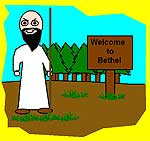 Monday morning (29 May 2006) at the CSBS there was a special session entitled “Curses and Curse Stories in Antiquity / Les Malédictions dans l’Antiquité Ancienne.” This special two-year session is headed up by Tony Chartrand-Burke, who teaches Biblical Studies at the Atkinson School of Arts and Letters at York University in Toronto, Ontario. I had the priviledge of getting to know Tony at this year’s CSBS — I actually shared a suite with him and a couple other guys (including Phil Harland, of Religions of the Ancient Mediterranean blog fame). Tony is a great guy and he has done an excellent job with this project. You can view the project website, including an annotated bibliography, here.
Monday morning (29 May 2006) at the CSBS there was a special session entitled “Curses and Curse Stories in Antiquity / Les Malédictions dans l’Antiquité Ancienne.” This special two-year session is headed up by Tony Chartrand-Burke, who teaches Biblical Studies at the Atkinson School of Arts and Letters at York University in Toronto, Ontario. I had the priviledge of getting to know Tony at this year’s CSBS — I actually shared a suite with him and a couple other guys (including Phil Harland, of Religions of the Ancient Mediterranean blog fame). Tony is a great guy and he has done an excellent job with this project. You can view the project website, including an annotated bibliography, here.
Tony Chartrand-Burke started the morning with a methodological probe, “Studying Curses and Curse Stories: Some Musings on Methodology.â€? This introduction to the special session included a summary of the results of an annotated bibliography currently in progress and some discussion on such issues as the forms, functions, and reception of curses and curse stories in antiquity. Tony is a master communicator and wasn’t even phased by the fire alarm going off in the middle of his introduction (I’m not sure the fire marshal would approve of Tony blocking the exits and yelling, “Stop or I will curse you” to all who dared to approach! :-)). 
One of the highlights of the morning for me (being such a simpleton) was the South-Park-esque comic Tony showed about Elisha calling down a curse on a group of children and a couple bears killing a bunch of them (to view the comic, see here; to read the biblical account, go to 2Kings 2:23-25. Please note that I do not endorse the site on which the comic is found — nor do I endorse the comic, I just thought that it was kind of funny in a twisted sort of way).
The second paper of the morning was “Joshua’s Curse on Jericho: Fulfillment and Partial Reversalâ€? by Daniel Miller (Bishop’s University). Miller began with an excellent discussion of magic and incantations in the ANE, which led into a discussion of the “syntax” of incantations and incantatory curses. He then briefly explored Joshua’s incantatory curse on anybody who would rebuild Jericho in Josh 6:26. This curse is fulfilled in 1 Kgs 16:34, when one Hiel of Bethel rebuilds the city “at the cost of Abiram his firstbornâ€? and “of his youngest son Segub.â€? In a related story in 2 Kgs 2:20-21, the “man of Godâ€? Elisha purifies the Jericho spring (presumably poisoned by Joshua’s curse) with a magical ritual that includes an incantation. Taken together, these three passages constitute a discontinuous “curse storyâ€? of the Deuteronomistic historian (containing not one but two incantations). I thought Miller’s paper was very well done, though one question that it raised in my mind is how can one distinguish incantations with prayers.
Then Christine Mitchell (St. Andrew’s College), who is always entertaining, delivered a paper mysteriously entitled, “Writing / Elijah / Cursing: 2 Chronicles 21:11-20.″ She focused on 2 Chr 21:11-20, where the Chronicler relates the story of Elijah cursing — via a letter — King Jehoram with illness. This curse story is also the only story of Elijah in Chronicles and the only written curse found in the book. Mitchell argued that the figure of Elijah should be read as a type of the implied author “the Chronicler,â€? and the cursing letter and its fulfillment as a parable for the text and reception of Chronicles. Interesting, though I am not sure I bought it!
The next paper, “Curses and Ideology among the Qumran Covenanters� was delivered by Sarianna Metso, religion professor at the University of Toronto. She focused on four texts (1QS 2; 1QM 13; 4QCurses; and 1QBer) and illustrated how they do not just imitate the biblical text, but give expression to specific ideological emphases of the Qumran community, such as their dualistic worldview. A motivational shift from law to wisdom can be detected: whereas curses in the Hebrew Bible have their ideological basis in the conduct-consequence relationship of covenantal discourse, curses in the Essene writings often function as an expression of the dualistic worldview of the Qumran covenanters, stating the (predestined) fate of an individual not belonging in the lot of the sons of light.
Unfortunately, I had to leave before the final paper of the morning, “Divine Violence and Righteous Angerâ€? by Kimberly Stratton (Carleton University). Here is the abstract to her paper: “This paper explores the role violence plays in curses and eschatological imaginings, where violence is anticipated for another group. How does calling down divine/demonic violence/vengeance upon an “otherâ€? serve to alleviate a sense of injustice or suffering? What is the history and relationship between curses and fantasies of eschatological judgment? How was this violence regarded in its ancient context?”
On the whole, I quite enjoyed the session. Kudos to Tony for a well-organized and run session.

Pingback: Codex: Biblical Studies Blogspot » Blog Archive » Go Up Baldy: The Curse of Baldness